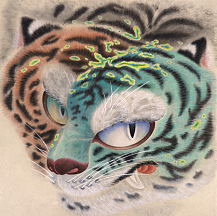Christmas noise drama
The actors of “Krippenspiel” told Christmas stories in the dada style at Erarta.
The creative association “Teatral’naya Laboratoriya” performed a play “Krippenspiel” at Erarta. “Krippenspiel” is a play written by Hugo Ball, a German poet and playwright, one of the founders of Dadaism. Dada means a children's babbling. Dadaism is an artistic movement, an avant-garde attempt to find a universal language in the early twentieth century. Therefore, you do not need a translation to understand this performance. The Bible story of the birth of Jesus is performed with sounds such as a screaming mother, a crying baby, whispering hay in the barn, a bleating sheep and whispering prayers.
According to Vadim Maximov, the director of the play, his production is a kind of performance, where the main thing is energy of particular sounds. The actors play different roles all the time. A bull-calf turns into a star, Joseph into a camel, and over all there is a naughty blond angel. Christmas is shown both like a light day and an unease of the future tragedy at the same time. You can see Jesus, a baby doomed to death. No wonder that you can see some nails among the Kings. Moreover at the end of the play the actors start building a wooden cross.
The members of “Teatral’naya Laboratoriya” are looking for new forms of stage speech. At the heart of this search there is the concept of the dynamic theatre, founded by Antonin Artaud, the French avant-garde playwright and theatre director. The idea of the theatre of cruelty belongs to him too. This cruelty has something in common with catharsis of the ancient Greek theatre, where people got the purification and purgation of emotions through art. It is necessary to break traditions, the domestic and superficial to discover the true meaning of existence.
As the director said, the most important task of their plays is to join the actors and the audience, make a kind of collective unconscious perception to maintain the cosmic harmony. It is an intelligent drama, based on archetypes, myths and the timeless themes of good and evil...





















